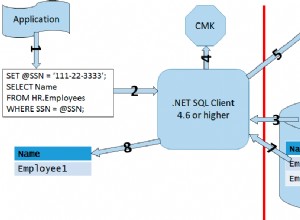Beispiel für die Verwendung von Junction/Intersect-Tabellen.
create table subscription_plans
(
id int not null auto_increment primary key, -- common practice
name varchar(40) not null,
description varchar(255) not null,
price decimal(12,2) not null
-- additional indexes:
);
create table pricing_offers
(
id int not null auto_increment primary key, -- common practice
name varchar(40) not null,
description varchar(255) not null
-- additional indexes:
);
create table so_junction
( -- intersects mapping subscription_plans and pricing_offers
id int not null auto_increment primary key, -- common practice
subId int not null,
offerId int not null,
-- row cannot be inserted/updated if subId does not exist in parent table
-- the fk name is completely made up
-- parent row cannot be deleted and thus orphaning children
CONSTRAINT fk_soj_subplans
FOREIGN KEY (subId)
REFERENCES subscription_plans(id),
-- row cannot be inserted/updated if offerId does not exist in parent table
-- the fk name is completely made up
-- parent row cannot be deleted and thus orphaning children
CONSTRAINT fk_soj_priceoffer
FOREIGN KEY (offerId)
REFERENCES pricing_offers(id),
-- the below allows for only ONE combo of subId,offerId
CONSTRAINT soj_unique_ids unique (subId,offerId)
-- additional indexes:
);
insert into subscription_plans (name,description,price) values ('plan_A','description',9.99);
insert into subscription_plans (name,description,price) values ('plan_B','description',19.99);
insert into subscription_plans (name,description,price) values ('plan_C','description',29.99);
select * from subscription_plans;
insert into pricing_offers (name,description) values ('free donuts','you get free donuts, limit 3');
insert into pricing_offers (name,description) values ('extra sauce','extra sauce');
insert into pricing_offers (name,description) values ('poney ride','Free ride on Wilbur');
insert into pricing_offers (name,description) values ('bus fare -50%','domestic less 50');
select * from pricing_offers;
insert so_junction(subId,offerId) values (1,1); -- free donuts to plans
insert so_junction(subId,offerId) values (1,2),(2,2),(3,2); -- extra sauce to plans
insert so_junction(subId,offerId) values (3,3); -- wilbur
insert so_junction(subId,offerId) values (1,4),(2,4),(3,4); -- bus to plans
select * from so_junction;
-- try to add another of like above to so_junction
-- Error Code 1062: Duplicate entry
-- show joins of all
select s.*,p.*
from subscription_plans s
join so_junction so
on so.subId=s.id
join pricing_offers p
on p.id=so.offerId
order by s.name,p.name
-- show extra sauce intersects
select s.*,p.*
from subscription_plans s
join so_junction so
on so.subId=s.id
join pricing_offers p
on p.id=so.offerId
where p.name='extra sauce'
order by s.name,p.name
Grundsätzlich fügen Sie in die Verbindungstabelle ein und löschen sie (in diesem Beispiel gibt es keine wirklich gute Aktualisierung).
Saubere und schnelle Joins, ohne sich mit langsamen, unhandlichen Sets ohne Indizes herumschlagen zu müssen
Niemand kann mehr auf dem Wilbur the Poney fahren? Dann
delete from so_junction
where offerId in (select id from pricing_offers where name='poney ride')
Fragen Sie, wenn Sie Fragen haben.
Und viel Glück!




